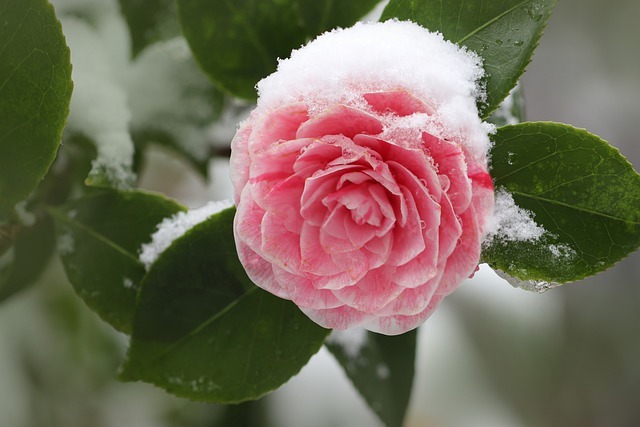Roses are some of the most popular and beautiful flowers in flower gardens all over…
How to Protect Plants From Frost
Home » Landscaping Blog » How to Protect Plants From Frost
Protecting Plants From Frost
Winter is on its way and there’s no better way to spend a morning than in your garden, making sure all of your plants are protected and ready for the cold temperatures and frost that will soon be rolling through.
Did you know that protecting outdoor plants from frost can be as easy as covering them with a blanket? This is an especially good idea if your plants didn’t survive last year’s cold temperatures and you want to try again this spring.
If they do tend to survive, you can plant them in the ground outside once the danger of frost is over. If you’re in Topsail Island, Wilmington, Sneads Ferry, Hampstead, NC and nearby areas, Get Right Enterprises can help with planting flowers and maintaining your landscape. Read on to learn some great ways to protect plants from frost this season!

How Does Frost Occur?
When water vapor in the air freezes and turns into ice crystals, it turns to frost. How much damage this causes to plants depends on how long the cold weather lasts and whether or not there is any wind. It also depends on what kind of plant you’re talking about.
Which Plants Need Frost Protection?
Protecting plants from frost depends on the type of plant and how hardy it is. A good rule of thumb is that if the plant is native to a colder area, then it can probably survive most frosts.
How you protect each plant depends entirely on its specific characteristics and it is really up to your discretion. For example, if it’s a fruit tree that bears fruit, you might want to cover it with some kind of frost blanket during the coldest parts of winter to make sure the flowers don’t get nipped by frost, but if it’s a tree that you don’t care about its leaves dropping in the fall/winter you probably won’t bother covering it.
If you have any evergreen or even semi-evergreen shrubs or trees (shrubs and trees that stay green all year round), those will need a completely different kind of protection from cold weather. Most people don’t think to cover evergreens, but during windy or very cold nights, they can be just as susceptible to frost damage as deciduous plants.
How you protect them is going to have to depend on how fast it gets cold where you live and if the evergreen is a very young one or an older, well toughened up one.
For example, if you have a mugo pine that’s already several years old and between 4-8 ft tall, it’s probably going to be fine through the winter even with no protection, but a six week old miniature spruce might need to be covered at night so it doesn’t get frostbite.
Protecting your plants from the cold is as simple as covering them with a blanket or tarp, but it can be just as dangerous if done wrong. How you protect each plant also depends on how high the winds usually are where you live during winter storms and if there’s any danger of animals damaging them.
Non-Hardy Plants
You should cover any non-hardy plants such as newly planted trees, newly transplanted flowers, and seedlings. If the plants don’t survive the cold weather, you can always replant them when it gets warmer outside.
Hardy Plants
Hardy plants are those that were previously planted in your garden last year. If they survived (and they should have if they’re hardy), then you do not need to cover them.
Frost-Protection Procedures
There are several different ways to protect plants from frost. Here’s how you can do it.
Plastic Bottle “Hothouse”
If you have seedlings or potted plants, you can use plastic bottles with their bottoms cut off. This is also an easy way to start seedlings for your garden. Cut off the bottoms of two plastic bottles, put them over the plants in your garden, and punch a few holes in them to let air circulate.
This works especially well when it is cold out and you have several seedlings in one large pot. Cover your plants loosely to protect them from frost without sacrificing much sunlight. Late in the fall, cover your garden with a blanket or tarp. Make sure that you can get underneath them and that they aren’t touching your plants.
Cover With Blankets
That’s right — you can cover your plants with a blanket. How to do it? You can tuck the blanket around the base of your plant.
Covering plants with a blanket during the winter will protect them from frost. To ensure maximum protection, be sure to cover the plant’s crown, not its leaves. Be sure to take off your blanket in the morning! There is only so much heat that can be produced by one plant and covering it for too long can cause damage or even kill it.
If you live in a particularly cold area, you may wish to cover your plants with aluminum foil instead of a blanket. The aluminum foil will reflect more heat back towards the plant and has been known to protect some plants from frost damage (although this method is not as effective as using a blanket).
Add Mulch
Mulching around your plants is a great way to protect them during winter, especially if they are perennial or frost-tender. How you mulch will depend on what you’re mulching around. If it’s your deciduous trees/shrubs that lose their leaves in the fall and grow new ones in the spring, you can use leaves from other trees as mulch, but make sure they aren’t poisonous to your plants.
If you don’t have any leaves to spare or if they are evergreen/semi-evergreen shrubs and trees that stay green all year round, there’s also bark mulch available for this purpose. How much material you’ll need for this is going to depend on how big your plants are.
Protecting each plant will have to depend on what kind of protection you are giving it. How you protect each one might also have to do with which way the wind usually blows in your area during winter storms and if there are any animals that might damage them.
Move Containers Indoors
If you have a container garden outside during the summer and want to keep them going through winter, all you have to do is bring them inside. How you move the plants will depend on how big each one is as well as what type of material it’s potted in.
If it’s a plant that has been in the same pot for a while and is already root bound, you might want to consider cutting away any dead material and repotting it. How you should move your container plant also depends on what kind of weather you’re having at the time as well as if there’s any danger of animals damaging them.
Making Your Own Hot Water Bottles
Making your own hot water bottles is a great way to keep plants from frost damage. Thoroughly clean out an empty plastic bottle and add a half cup of very hot water.
Seal the bottle with duct tape or masking tape. If you have extra, you can add some dried beans to create a better seal against the outside air; if not, however, it is not necessary for this DIY.
Hang the hot water bottle upside down in the plant’s container and place the container near your plants. The heat that is given off will protect them from frost or even cold winds!
You’re done! Now that you know how to keep your garden safe from frost damage, it’s time to go plant some seeds or switch those seedlings outside!
For Assistance With Planting and Landscaping Contact Get Right Enterprises
The temperature can drop well below freezing during the winter months, which has a detrimental effect on plants. How to protect plants from frost is a question that many gardeners struggle with during the cold season, but covering plants with blankets and making hot water bottles are two effective ways of protecting your plants from frost damage.
If you want help with your garden, contact Get Right Enterprises at 910-264-6782 today. Our landscaping professionals will be glad to help you.
Contact Form
We would love to hear from you! Please fill out this form and we will get back to you shortly.
Related Posts
- How to Protect Roses from Diseases
- The Best Time to Plant Flowers in Eastern North Carolina
Learn when the best time is to plant flowers if you live on the North…




